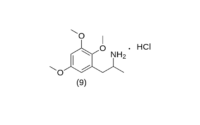TMA-4 User report
Dosage: greater than 80 mg.
Duration: perhaps 6 h.
(with 80 mg) I was concerned about life issues, with much introspection, for about 6 hours. There were no subjective physical symptoms. It was comparable to about 50 micrograms of LSD, or to 120 milligrams TMA, for me.

Extensions and commentary: That is the sum total of the knowledge of subjective effects that exist. There was such a precious small amount of the final hydrochloride salt that, by the time the needed build-up of dosage had been completed, there was just enough left for this single trial, which was conducted in South America. Based upon the volunteered comparisons to LSD and TMA, a potency for this compound has been published that states that it is 4x the potency of mescaline, or 4 M.U. The material must be re-synthesized, and re-evaluated with the now-accepted protocol.
In the future re-synthesis, there will be a considerable improvement made with the several steps that are described above. The products from the preparations of the phenol, the allyl ether, the Claisen rearrangement, the methylation of the new phenol, and the isomerization to the mixture of cis- and trans-propenylbenzenes were all conducted without the benefit of a Kugel-Rohr apparatus. The products became progressively thick and blacker, and it was only by the grace of getting a solid at the trans-propenyl stage that some degree of purity could finally be obtained. All of the intermediates are certainly white oils, and when this preparation is repeated, they will be distilled at each and every stage.
This 2,3,5-orientation of the methoxy groups on the aromatic ring is far and away the most difficult tri-substitution pattern known to chemists. There just isn’t any simple way to put it together. The 2-carbon phenethylamine (2,3,5-trimethoxyphenethylamine) had been synthesized quite a while ago. Its role as a substrate for liver amine oxidase in in vitro studies has been explored, but it has never been tried in man. Even more bizarre is the amphetamine with this oxygenation pattern, in which a methylenedioxy ring has replaced the two adjacent methoxyl groups. This is the material 2,3-methylenedioxy-5-methoxyamphetamine, or MMDA-4. Despite its theoretical appeal (being one of the six possible MMDA derivatives) and it’s synthetic challenge (as with the 2,3,5-trimethoxy things above, everything is simply in the wrong position) the compound is of unknown pharmacology. This follows, quite logically, from the fact that it has never been synthesized. No one has yet put together a workable procedure that would make it. In the course of making all possible positional isomers of MMDA explicitly Schedule I drugs, the DEA has named this compound, and since it was specifically named, it was entered into the Chemical Abstracts. So it is listed in the literature, at least it is in the Chem. Abstracts. But it is in reality completely unknown. Some day, some one somewhere will have a light bulb go on over his head, and find a synthetic process that will make it. Of course, the moment it is made, an illegal act will have occurred, at least in the United States as long as the present laws remain unchanged, as it is currently a Schedule I drug.
Pihcal, A. Shulgin (register to see this book)

